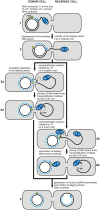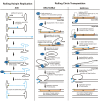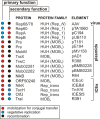The Different Faces of Rolling-Circle Replication and Its Multifunctional Initiator Proteins
- PMID: 29250047
- PMCID: PMC5714925
- DOI: 10.3389/fmicb.2017.02353
The Different Faces of Rolling-Circle Replication and Its Multifunctional Initiator Proteins
Abstract
Horizontal gene transfer (HGT) contributes greatly to the plasticity and evolution of prokaryotic and eukaryotic genomes. The main carriers of foreign DNA in HGT are mobile genetic elements (MGEs) that have extremely diverse genetic structures and properties. Various strategies are used for the maintenance and spread of MGEs, including (i) vegetative replication, (ii) transposition (and other types of recombination), and (iii) conjugal transfer. In many MGEs, all of these processes are dependent on rolling-circle replication (RCR). RCR is one of the most well characterized models of DNA replication. Although many studies have focused on describing its mechanism, the role of replication initiator proteins has only recently been subject to in-depth analysis, which indicates their involvement in multiple biological process associated with RCR. In this review, we present a general overview of RCR and its impact in HGT. We focus on the molecular characteristics of RCR initiator proteins belonging to the HUH and Rep_trans protein families. Despite analogous mechanisms of action these are distinct groups of proteins with different catalytic domain structures. This is the first review describing the multifunctional character of various types of RCR initiator proteins, including the latest discoveries in the field. Recent reports provide evidence that (i) proteins initiating vegetative replication (Rep) or mobilization for conjugal transfer (Mob) may also have integrase (Int) activity, (ii) some Mob proteins are capable of initiating vegetative replication (Rep activity), and (iii) some Rep proteins can act like Mob proteins to mobilize plasmid DNA for conjugal transfer. These findings have significant consequences for our understanding of the role of RCR, not only in DNA metabolism but also in the biology of many MGEs.
Keywords: conjugal transfer; horizontal gene transfer; mobile genetic elements; multifunctional protein; rolling-circle replication; transposition.
Figures




References
Publication types
LinkOut - more resources
Full Text Sources
Other Literature Sources

